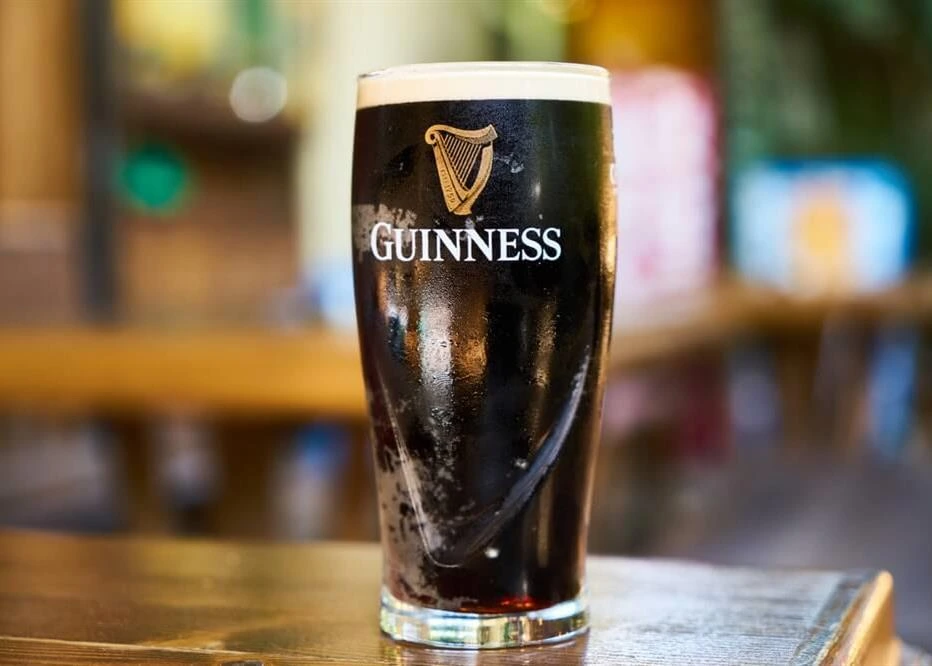
When you think of Guinness, what comes to mind? Is it the rich, dark stout swirling in a pint glass, the iconic harp logo, or perhaps images of lively Irish pubs? While many are familiar with the legendary brew, there’s a fascinating world of history, science, and quirky details behind every pour. From its surprisingly simple ingredients to its groundbreaking innovations and deep-rooted cultural impact, Guinness is much more than just a beer. Join us as we dive into some truly captivating facts about this beloved Irish icon that will undoubtedly surprise and entertain you.
Guinness was founded in 1759 in Dublin, Ireland by Arthur Guinness, who embarked on a brewing journey that would lead to one of the world’s most iconic stout beers. The initial venture began with a significant commitment, as Arthur Guinness signed a remarkable 9,000-year lease on the historic St. James’s Gate location, securing the premises for approximately $60 per year, a deal that also included invaluable free access to a crucial water supply. This incredibly long-term lease, however, eventually became obsolete when the property was later purchased and significantly expanded to accommodate the growing brewery’s needs.
The quintessential Guinness stout is crafted from a remarkably simple yet precisely balanced combination of just four core ingredients: malted barley, hops, brewer’s yeast, and water. Despite the apparent simplicity of these components, the brewing of Guinness is a highly intricate process that demands profound scientific expertise across various disciplines. To achieve its distinctive flavor and consistency, brewers must possess in-depth knowledge of microbiology, understanding the role of various microorganisms; mycology, focusing on the specific yeast strains employed; bacteriology, ensuring the absence of undesirable bacteria; and thermodynamics, crucial for controlling temperature and energy transformations throughout the brewing stages.
Achieving the perfect pour of a pint of Guinness is an art form governed by an official six-step process, meticulously designed to ensure optimal presentation and taste. This ritualistic pouring process takes precisely 119 and a half seconds to complete. It begins by filling the pint glass three-quarters of the way, holding it at a precise 45-degree angle to allow for proper cascading and aeration. After this initial fill, the pint is left to settle for approximately one minute, allowing the nitrogen to work its magic and the head to form correctly, before the remaining quarter of the glass is filled to perfection.
There is an equally precise and officially recommended method for drinking a pint of Guinness, championed by Mark McGovern, the former brand manager of the Guinness Storehouse. According to McGovern, the proper technique involves holding your elbow perpendicular to the floor, ensuring the glass is at the ideal angle. The key is to drink directly through the head of the beer, which is the most hoppy and bitter part, until you begin to experience the sweeter notes of the stout’s body underneath, creating a layered and evolving taste experience.
The innovative white spherical objects found within Guinness cans are known as “widgets,” a groundbreaking invention designed to replicate the draught experience at home. These widgets are ingeniously filled with nitrogen-infused beer, and upon opening the can, the sudden change in pressure causes the nitrogen to be released, creating the signature creamy, foamy head that is characteristic of a perfectly poured pint of Guinness. The significance of this invention was widely recognized when, in 1991, the Guinness widget notably surpassed the internet in a public poll, being declared the best invention of the last 40 years.
Beyond the brewing of beer, Guinness also played a pivotal role in the creation of a world-renowned publication, The Guinness Book of World Records. This iconic book was first established in 1954 with the practical purpose of resolving common disputes and arguments that frequently arose in pubs, providing an authoritative source for settling debates on extraordinary facts and achievements.
Arthur Guinness’s initial commitment to his brewery was underscored by a remarkable 9,000-year lease on the St. James’s Gate location, secured at an astonishingly low rate of approximately $60 per year. This long-term agreement also included the invaluable benefit of free access to a consistent water supply, a critical resource for brewing. However, this historic lease eventually ceased to be in effect when the property was acquired and substantially expanded to accommodate the growing demands of the globally recognized brewery.
For those mindful of their caloric intake, a 20-ounce pint of Guinness offers a surprisingly moderate 210 calories. This makes Guinness a relatively light alcoholic beverage when compared to other common drinks, notably containing fewer calories than a standard glass of milk or even a glass of orange juice.
Ordering a Guinness at a bar in Ireland often involves a unique and culturally specific set of gestures and phrases. Instead of simply asking for “a Guinness,” patrons can use a variety of colloquial expressions such as “a pint of the plain,” “the good stuff,” or simply “your best.” Alternatively, a common and easily understood non-verbal cue is to simply hold your forefinger in the air, a gesture that bartenders in Ireland readily understand as a request for a pint of Guinness.
It is a widely held belief, and scientifically supported, that Guinness genuinely tastes better when consumed in Ireland. This enhanced flavor experience is predominantly attributed to two key factors: freshness and stringent quality control. When enjoyed in its country of origin, the beer is typically consumed closer to its brewing date, ensuring peak flavor, and the brewery’s rigorous quality control standards are most directly observable within Ireland.
Guinness has a vast global footprint, with its stout being brewed in more than 150 countries worldwide, demonstrating its widespread appeal and international reach. This extensive network includes diverse nations such as Nigeria and Indonesia, highlighting the brand’s ability to adapt and thrive in various markets across the globe.
The sheer volume of Guinness consumed globally is staggering, with over 10 million glasses sold every single day across the world. The original Dublin brewery, a central hub for Guinness production, contributes significantly to this impressive figure, brewing approximately 3 million pints daily to meet the immense global demand.
Historically, Guinness’s product line was not exclusively focused on stout. Originally, the brewery also produced an ale alongside its renowned porter. However, in 1799, a strategic decision was made to discontinue the production of ale, allowing the company to concentrate its efforts and resources entirely on the increasingly popular and successful stout, which would ultimately become its signature product.
Guinness was a pioneering company in employee welfare, demonstrating a progressive approach to benefits as early as 1928. In that year, Guinness employees were provided with comprehensive on-site medical and dental care, highlighting a commitment to their well-being. Additionally, they received two free pints of Guinness after each shift, a unique perk, and were granted full pensions, making Guinness one of the earliest companies to offer such extensive employee benefits.
A significant milestone in Guinness’s history was celebrated on September 24, 2009, at precisely 5:50 P.M., when Ireland commemorated the 250th anniversary of the brewery with a nationwide event dubbed “Arthur’s Day.” This special occasion honored the legacy of Arthur Guinness and his enduring contribution to Irish culture and global brewing.
As part of the grand celebration for Guinness’s 250th anniversary in 2009, a unique and imaginative initiative was undertaken: a submarine bar was specially commissioned. A contest was held, and the fortunate winners were granted the extraordinary opportunity to enjoy a pint of Guinness onboard this one-of-a-kind underwater drinking establishment, creating a truly memorable experience.
Guinness continues to maintain its prestigious position as the world’s largest exporter of stout, solidifying its dominant presence in the global beer market. The company remains at the forefront of brewing technology, operating as a technologically modern brewery that even boasts its own power plant, showcasing its commitment to efficiency and innovation in production.
Historically, in Ireland, a unique incentive was offered to blood donors until 2009: after giving blood, individuals were rewarded with a complimentary pint of Guinness. This practice highlighted a cultural connection between the beloved stout and acts of community service, though it has since been discontinued.
While Guinness is commonly perceived as a black or dark brown beer, due to the visual impact of roasted barley used in its brewing, it actually possesses a subtle and rich dark ruby red color when viewed against a light source. This nuanced hue is a result of the specific malt profiles and roasting processes employed in its production.
For those with dietary considerations, it’s important to note the distinction between different Guinness products: while draught Guinness, as traditionally served from a tap, is not considered vegan due to the use of fining agents derived from fish bladders in its production, Guinness Extra, a bottled variant, is indeed vegan-friendly, making it suitable for a wider range of consumers.
Guinness holds a significant cultural presence in Ireland, with half of all pints consumed in the country being Guinness. However, surprisingly, a substantial portion of Guinness’s global sales, a full 40%, occurs in Africa, underscoring the continent’s strong and growing appreciation for the iconic stout.
The Guinness brewery has become a major tourist attraction in Ireland, cementing its status as the top-visited destination in the country. Annually, over one million people embark on a journey to the Guinness Storehouse, immersing themselves in the history, brewing process, and tasting experience of this celebrated Irish stout.
Early print advertisements for Guinness famously promoted the slogan, “Guinness is good for you,” suggesting health benefits. Interestingly, modern research has indeed found that Guinness contains antioxidant compounds that are comparable to those found in certain fruits and vegetables, offering a scientific basis for some of those historical claims regarding its nutritional value.
The harp, a traditional symbol of Ireland, became the official trademark for Guinness in 1876. To avoid any confusion or conflict with the official national symbol, a unique agreement was reached: the harp used in the Guinness logo would consistently face right, while the official governmental use of the harp symbol would always face left, providing a clear distinction between the brand and the nation.
In a reflection of historical societal and religious norms, until 1939, Guinness had a controversial policy regarding its brewers’ personal lives. If a Guinness brewer intended to marry a Catholic individual, their resignation from the company was formally requested, highlighting a period of religious segregation within the workforce.
Interestingly, around 1860, Arthur Guinness’s grandson, who had taken control of the thriving brewery, made a significant philanthropic contribution by donating nearly $200,000 towards the restoration of St. Patrick’s Cathedral. This substantial sum demonstrated the family’s commitment to community and historical preservation.
To ensure consistent quality and taste, every single batch produced at the Guinness factory undergoes a rigorous taste-testing process. This meticulous quality control measure is implemented to guarantee that no substandard batches are ever released to the public, upholding the brand’s reputation for excellence.
During the 1960s, Guinness implemented a policy of segregating employees by gender within the workplace. This decision was made out of concern that men’s “lewd conversation” might be offensive to women, reflecting societal attitudes and efforts to manage workplace interactions during that era.
The Guinness Storehouse, a popular visitor attraction, features a distinctive and impressive “Gravity Bar,” which is perched an impressive 150 feet off the ground. This makes it the highest bar in all of Dublin, offering visitors panoramic views of the city while enjoying a pint of Guinness.
Frequently Asked Questions About Guinness:
1. What are the main ingredients in Guinness? Guinness is famously brewed with just four core ingredients: malted barley, hops, brewer’s yeast, and water. The distinctive dark color and roasted flavor come from a portion of the malted barley being heavily roasted, similar to how coffee beans are treated. While the list of ingredients is short, the precise balance and brewing process are what give Guinness its unique character.
2. Is Guinness truly black? What gives it its color? Despite its common nickname, “the black stuff,” Guinness is not actually black. If you hold a pint of Guinness up to a strong light, you’ll observe a deep, dark ruby red hue. This rich color is primarily due to the roasted barley used in the brewing process. The intense roasting of a small portion of the barley creates the dark pigment that colors the beer, giving it its characteristic appearance.
3. What is the “widget” in Guinness cans, and how does it work? The “widget” is a small, plastic, spherical device found inside cans of Guinness Draught. It’s filled with nitrogen-infused beer. When the can is opened, the pressure inside the can drops, causing the nitrogen and a small amount of beer from the widget to be forced out through a tiny hole. This creates a powerful surge of incredibly fine bubbles throughout the beer, replicating the creamy, cascading effect and the signature dense head of a draught pint poured in a pub. In 1991, this innovative invention even won the Queen’s Award for Technological Achievement, famously beating the internet in a survey for the best invention of the last 40 years.
4. What is the perfect way to pour a pint of Guinness? How long does it take? Pouring a perfect pint of Guinness is considered an art form, with an official six-step process that takes precisely 119.5 seconds (often rounded to 120 seconds or two minutes).
- The Tilt: Hold a clean, dry Guinness glass at a 45-degree angle.
- The First Pour: Aim the spout at the harp on the glass and pour until the glass is three-quarters full.
- The Settle: Stop pouring and let the pint settle for about 86 seconds (roughly one minute). During this time, the “surge” of nitrogen bubbles will settle, and the creamy head will begin to form.
- The Top Up: After the settle, slowly top up the glass by pushing the tap handle away from you, pouring straight down until the head is “just proud” of the rim.
- The Presentation: Serve with the logo facing the customer. This two-part pour ensures the perfect creamy head and the optimal flavor experience.
5. How many calories are in a pint of Guinness? A standard 20-ounce (568 ml) pint of Guinness Draught contains approximately 210 calories. This is often less than many other lagers, and surprisingly, even less than a glass of milk or orange juice, dispelling the myth that Guinness is a heavy, high-calorie beer.
6. Is Guinness good for you? Does it have iron? Historically, Guinness ran a famous advertising slogan: “Guinness is good for you.” While it’s not a health drink, scientific research has found that Guinness contains antioxidant compounds, similar to those found in certain fruits and vegetables, which may offer some health benefits when consumed in moderation. However, the popular belief that Guinness is high in iron is largely a myth; a pint of Guinness contains only about 0.3 mg of iron, which is a negligible amount compared to the daily recommended intake.
7. Is Guinness vegan? Yes, as of 2017, Guinness Draught and several other Guinness products (including Guinness Extra Stout and Foreign Extra Stout) are vegan-friendly. Previously, Guinness used isinglass (a gelatin-like substance derived from fish bladders) as a fining agent to clarify the beer. However, the brewing process has been updated to use a new, non-animal-derived filtration system, making it suitable for vegans.
8. What is the alcohol content (ABV) of Guinness? The alcohol by volume (ABV) of Guinness varies depending on the specific product.
- Guinness Draught: Typically 4.2% ABV.
- Guinness Extra Stout (or Original): Also typically 4.2% ABV.
- Guinness Foreign Extra Stout: Often a stronger variant, ranging from 7.5% ABV or higher, depending on the market where it’s brewed and sold. Other variants like Guinness Baltimore Blonde or Guinness Special Export will have different ABVs.
9. Why does Guinness taste better in Ireland? Many aficionados claim Guinness tastes superior in Ireland, and there’s a scientific basis for this belief. The most likely reasons are freshness and quality control. In Ireland, particularly in Dublin near the St. James’s Gate brewery, the beer is often consumed very close to its production date, ensuring optimal flavor and freshness. Additionally, the local water quality and rigorous quality control measures at the primary brewery likely contribute to a consistent and superior taste experience compared to Guinness brewed or transported further afield.
10. How many countries is Guinness sold in, and how much is consumed globally? Guinness has an enormous global presence. It is sold in well over 100 countries and brewed in over 40. Globally, over 10 million glasses of Guinness are sold every single day, amounting to over 1.8 billion pints annually. The original Dublin brewery alone brews approximately 3 million pints daily to meet this immense worldwide demand.
11. What is the connection between Guinness beer and The Guinness Book of World Records? The connection is direct! The Guinness Book of World Records was founded in 1954 by Sir Hugh Beaver, who was then the managing director of Guinness Brewery. The idea originated from a pub argument about the fastest game bird in Europe, leading Beaver to realize there was no authoritative source to settle such factual disputes. He then commissioned the creation of a book to compile verifiable world records, specifically for the purpose of settling pub debates, and thus, The Guinness Book of World Records was born.
12. Why does the Guinness harp face a different direction than Ireland’s national symbol? The harp became the official trademark for Guinness in 1876. However, the harp is also the official national symbol of Ireland. To avoid confusion and legal conflict, an agreement was reached: the harp in the Guinness logo would always face right, while the official use of the harp as Ireland’s national emblem would always face left. This simple distinction allows both to exist uniquely.








